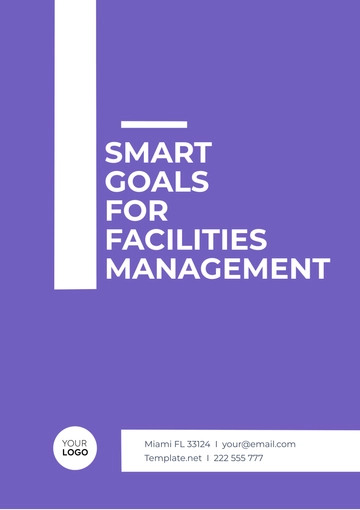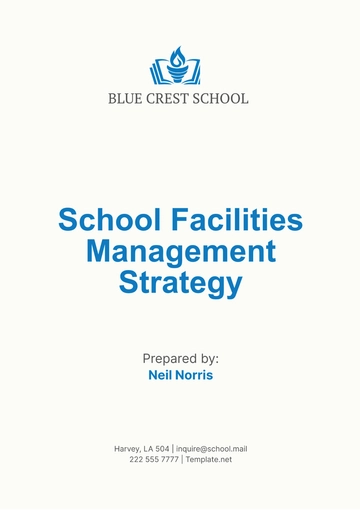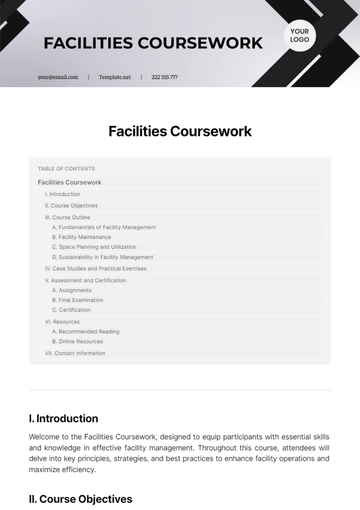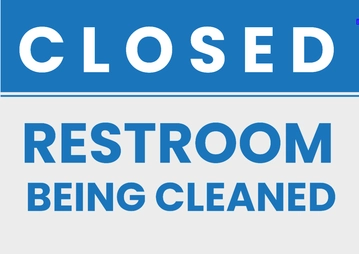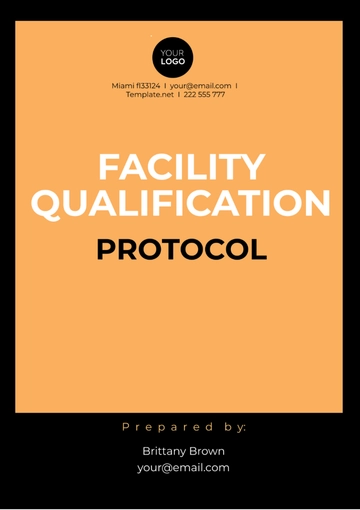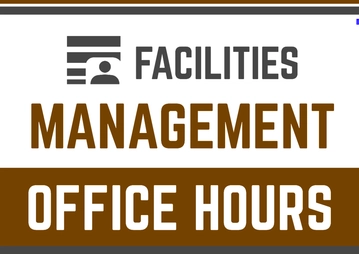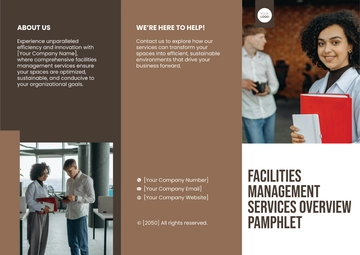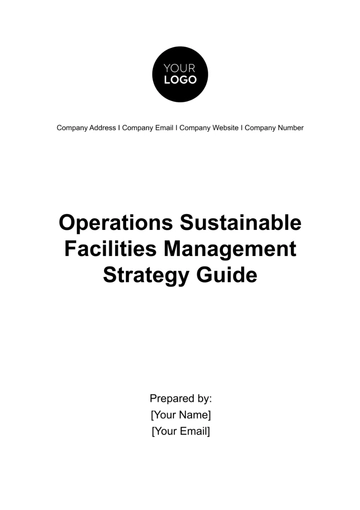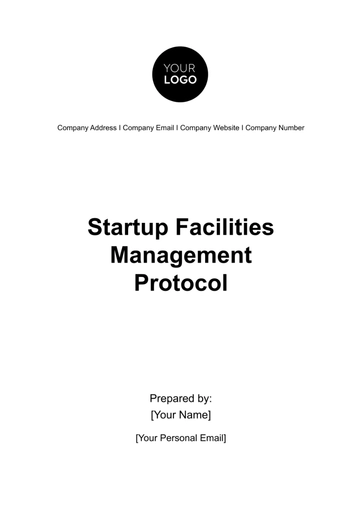Free School Facilities Management Strategy
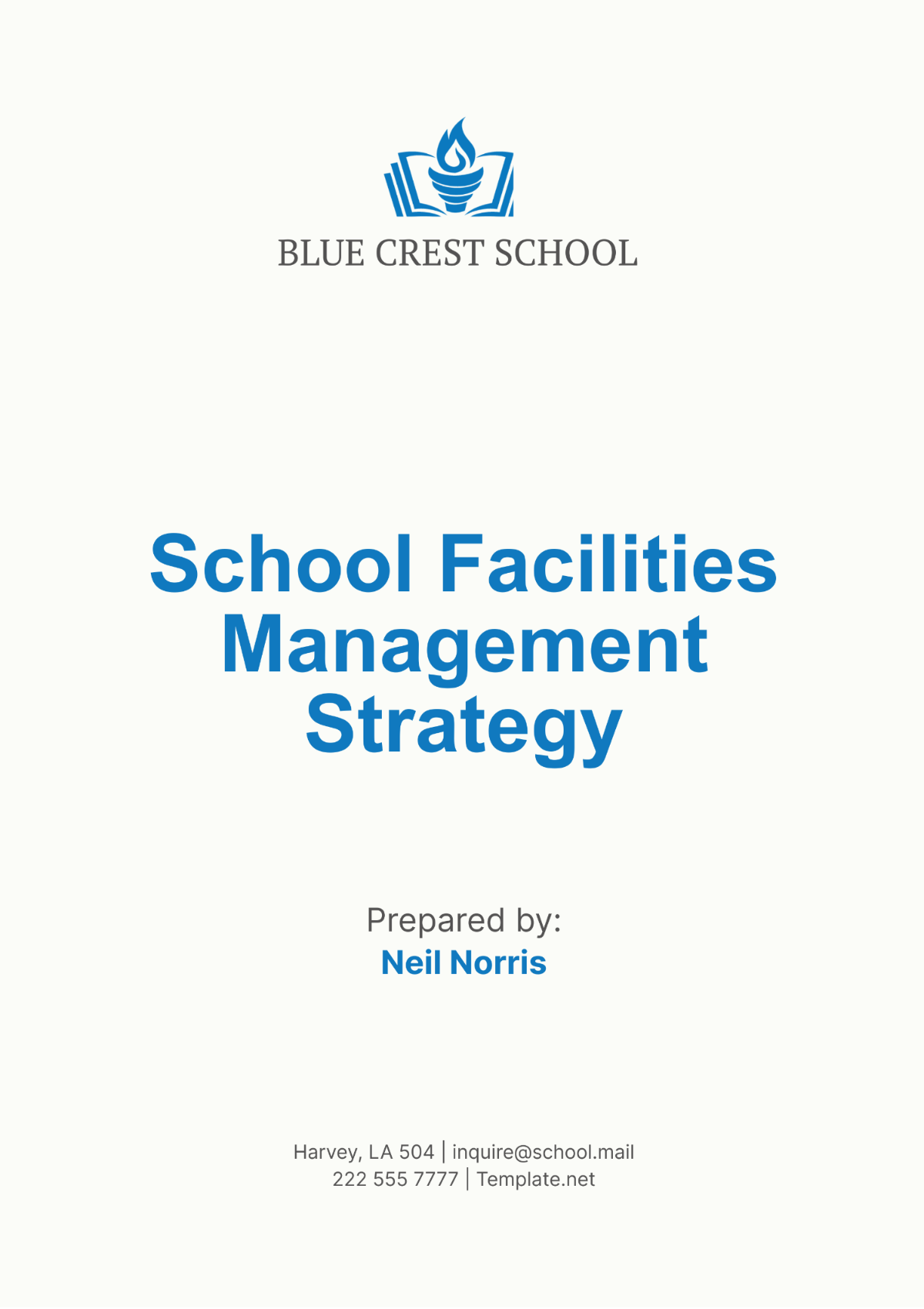
I. Introduction
The purpose of this School Facilities Management Strategy is to ensure that [Your Company Name] facilities are maintained at optimal conditions to provide a safe, efficient, and conducive environment for learning. This strategy outlines the management practices, procedures, and policies we employ to assess, maintain, and improve our facilities. It encompasses preventive, corrective, and predictive maintenance approaches, space utilization planning, security measures, sustainability practices, and stakeholder engagement to meet both current and future needs of the [Your Company Name] community.
II. Facility Inventory and Assessment
We maintain a comprehensive inventory of all school facilities, regularly assessing their condition to ensure they meet safety, accessibility, and compliance standards. This section provides detailed information on the size, capacity, and condition of each facility, as well as safety, accessibility, and compliance scores.
Facility Inventory
Facility | Size (sq ft) | Capacity | Condition |
|---|---|---|---|
Main Building | 30,000 | 600 | Good |
Science Laboratory | 2,500 | 60 | Excellent |
Gymnasium | 10,000 | 500 | Fair |
Library | 5,000 | 200 | Good |
Administrative Offices | 3,000 | 50 | Excellent |
Cafeteria | 4,000 | 300 | Good |
Playground | 8,000 | N/A | Fair |
Facility Safety and Compliance Assessment
Facility | Safety | Accessibility | Compliance |
|---|---|---|---|
Main Building | 9 | 8 | 10 |
Science Laboratory | 10 | 9 | 10 |
Gymnasium | 6 | 7 | 8 |
Library | 8 | 9 | 10 |
Administrative Offices | 10 | 10 | 10 |
Cafeteria | 8 | 8 | 9 |
Playground | 7 | 6 | 7 |
Rubric Guide for Scores
Safety Score
10: Fully compliant with all safety regulations, no hazards present
8-9: Minor issues that do not pose immediate safety risks
6-7: Moderate issues that require attention but not urgent
4-5: Significant safety issues, prompt action needed
1-3: Critical safety hazards, immediate action required
Accessibility Score
10: Fully accessible for all individuals, including those with disabilities
8-9: Generally accessible, minor improvements needed
6-7: Several accessibility barriers, moderate improvements needed
4-5: Many accessibility barriers, significant improvements needed
1-3: Not accessible, major renovations required
Compliance Score
10: Fully compliant with all relevant regulations and standards
8-9: Minor non-compliance issues, easily correctable
6-7: Moderate non-compliance issues, needs addressing
4-5: Significant non-compliance issues, urgent correction needed
1-3: Major non-compliance, immediate action required
III. Maintenance and Repairs
A. Preventive Maintenance
Preventive maintenance involves regular, scheduled servicing to ensure that facilities and equipment are functioning correctly and to prevent potential breakdowns. This proactive approach helps extend the lifespan of assets and maintain a safe environment.
Task | Frequency | Responsible Party |
|---|---|---|
Filter Replacement | Monthly | Maintenance Team |
Inspection and Testing | Quarterly | Safety Officer |
Cleaning and Inspection | Semi-Annually | Maintenance Team |
Leak Checks and Repairs | Monthly | Maintenance Team |
Bulb Replacement and Fixture Check | Quarterly | Electrician |
Safety Inspections | Monthly | Maintenance Team |
Software Updates and Cleaning | Monthly | IT Department |
B. Corrective Maintenance
Corrective maintenance addresses any repairs and issues that arise unexpectedly. This reactive approach ensures that any damage or malfunction is promptly repaired to minimize disruption and maintain safety.
Typical Issues | Resolution Time | Responsible Party |
|---|---|---|
Leaks, Blockages | Within 24 hours | Maintenance Team |
Power Outages, Faulty Wiring | Within 12 hours | Electrician |
Malfunctioning Units | Within 48 hours | HVAC Technician |
Cracks, Damages | Within 72 hours | Building Inspector |
Network Downtime, Hardware Failure | Within 24 hours | IT Department |
C. Predictive Maintenance
Predictive maintenance uses data and analytics to predict and prevent potential failures before they occur. By monitoring the condition of equipment and facilities, we can schedule maintenance activities at optimal times to avoid disruptions.
Condition Monitoring: Regularly monitor the condition of critical equipment (e.g., HVAC systems, electrical systems) using sensors and analytics to predict failures.
Data Analysis: Analyze maintenance records and operational data to identify patterns and predict future issues.
Scheduled Inspections: Implement scheduled inspections based on data-driven insights to address potential issues before they become critical.
Training: Ensure staff are trained in predictive maintenance techniques and the use of monitoring tools and software.
IV. Cleaning and Housekeeping
A. Daily Cleaning
Daily cleaning tasks are essential to maintain a clean and healthy environment. These tasks are performed every day to ensure that the school is ready for use each morning.
Classrooms: Sweep and mop floors, empty trash bins, wipe down desks and surfaces, clean whiteboards.
Restrooms: Clean and disinfect toilets, sinks, and floors, restock supplies, empty trash bins.
Hallways and Common Areas: Sweep and mop floors, empty trash bins, wipe down high-touch surfaces such as door handles and handrails.
Cafeteria and Food Preparation Areas: Clean and disinfect tables, chairs, and food preparation surfaces, sweep and mop floors, empty trash bins.
Offices and Staff Rooms: Vacuum carpets, dust surfaces, empty trash bins, clean windows and glass surfaces.
Playgrounds and Outdoor Areas: Pick up litter, empty trash bins, inspect for and address any hazards.
B. Periodic Cleaning
Periodic cleaning tasks are performed on a less frequent basis but are crucial for maintaining a deep level of cleanliness and addressing areas that require more intensive cleaning.
Deep Cleaning of Classrooms: Wash windows, clean blinds or curtains, shampoo carpets, clean under and behind furniture.
Restrooms: Deep clean and disinfect all fixtures and tiles, descale faucets and showerheads, clean ventilation grates.
Cafeteria and Kitchen: Deep clean kitchen equipment, clean and disinfect storage areas, perform a thorough cleaning of floors and walls.
Floor Maintenance: Buffing, waxing, and polishing hard floors, deep cleaning carpets.
Windows and Glass Surfaces: Clean all windows inside and out, clean skylights and other glass surfaces.
Ventilation Systems: Clean and replace air filters, inspect and clean ducts and vents.
V. Security and Safety
A. Security Measures
Security measures are implemented to safeguard [Your Company Name] against unauthorized access, theft, and other security threats. Each measure is designed to create a safe and secure environment for everyone.
Access Control: All entry points are secured with locks and monitored by security personnel. Visitors are required to check in at the front office and wear identification badges.
Surveillance Systems: Security cameras are installed at strategic locations throughout the school to monitor activity and deter potential security breaches.
Security Personnel: Trained security personnel are on-site during school hours and after-hours events to ensure the safety and security of students, staff, and property.
Visitor Management: All visitors must sign in at the front office, present identification, and state the purpose of their visit. They are issued temporary visitor badges to wear while on campus.
Emergency Alarms: Alarm systems are in place for fire, intrusions, and other emergencies. Regular testing and maintenance ensure they are functional and reliable.
B. Emergency Preparedness
Preparedness for emergencies involves regular drills and training to ensure that all students and staff know how to respond in various emergency situations. This proactive approach helps to minimize panic and confusion during actual emergencies.
Drill/Training Type | Frequency | Participants |
|---|---|---|
Fire Drills | Monthly | All Students & Staff |
Earthquake Drills | Quarterly | All Students & Staff |
Lockdown Drills | Twice a Year | All Students & Staff |
First Aid Training | Annually | Staff |
Active Shooter Training | Annually | Staff |
Severe Weather Drills | Twice a Year | All Students & Staff |
VI. Budgeting and Resource Allocation
A. Budget Planning
Budget planning involves allocating funds to various maintenance and operational needs within the school. This ensures that we have sufficient resources to address both routine and unexpected maintenance requirements, as well as improvements and upgrades to our facilities.
Category | Annual Allocation | Percentage |
|---|---|---|
Preventive Maintenance | $50,000 | 25% |
Corrective Maintenance | $30,000 | 15% |
Predictive Maintenance | $20,000 | 10% |
Cleaning and Housekeeping | $40,000 | 20% |
Security and Safety | $30,000 | 15% |
Training and Development | $15,000 | 7.5% |
Miscellaneous/Contingencies | $15,000 | 7.5% |
Monitoring expenditures is critical to ensure that funds are used efficiently and in alignment with our budget plan. We will conduct regular financial reviews to track spending, identify any deviations from the budget, and make adjustments as necessary to stay within our financial limits.
B. Resource Management
Resource management involves allocating materials, equipment, and manpower effectively to meet the needs of our facilities. This ensures that all maintenance tasks are completed on time and to a high standard.
Resource | Quantity/Amount |
|---|---|
Cleaning Supplies | Monthly stock replenishment |
Maintenance Tools | 20 sets |
Security Equipment | 15 cameras, 10 alarms |
Training Materials | Annual stock replenishment |
Maintenance Personnel | 10 full-time, 5 part-time |
Proper management of resources involves regular inventory checks, timely replenishment of supplies, and efficient deployment of personnel. By maintaining a well-organized resource management system, we can ensure that all maintenance and operational tasks are supported adequately.
VII. Review and Evaluation
Regular review and evaluation of our facilities management strategy are essential to ensure its effectiveness and relevance. We will conduct annual reviews to assess the performance of our maintenance processes, budget allocation, and resource management. Feedback from staff, students, and other stakeholders will be collected to identify areas for improvement. Based on the review findings, we will update our strategy to address any identified gaps and enhance the overall efficiency and effectiveness of our facilities management practices. This continuous improvement approach ensures that our facilities remain safe, well-maintained, and conducive to the educational environment.
- 100% Customizable, free editor
- Access 1 Million+ Templates, photo’s & graphics
- Download or share as a template
- Click and replace photos, graphics, text, backgrounds
- Resize, crop, AI write & more
- Access advanced editor
Explore the School Facilities Management Strategy Template on Template.net. This essential resource helps schools optimize their facilities effectively. Fully editable and customizable, it can be tailored to your school's unique needs. Improve maintenance scheduling, enhance resource allocation, and ensure efficient facility management. Elevate your school's infrastructure today with this editable in our AI Editor tool.
